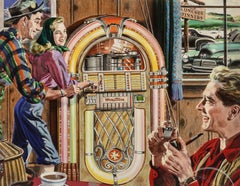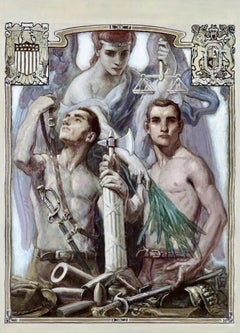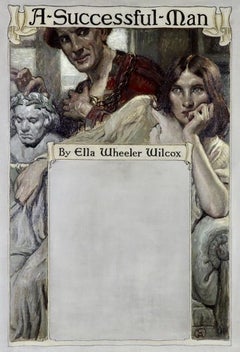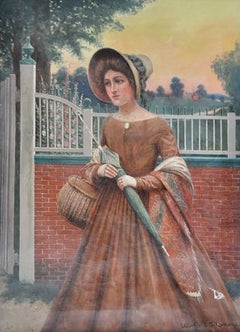Want more images or videos?
Request additional images or videos from the seller
1 of 6
Herbert PausLumberjacks
Price:$11,100
$12,500List Price
About the Item
- Creator:Herbert Paus (1880 - 1946, American)
- Dimensions:Height: 20 in (50.8 cm)Width: 16 in (40.64 cm)
- Medium:
- Period:
- Condition:
- Gallery Location:Fort Washington, PA
- Reference Number:Seller: 40181stDibs: LU38436687972
About the Seller
5.0
Recognized Seller
These prestigious sellers are industry leaders and represent the highest echelon for item quality and design.
Established in 1995
1stDibs seller since 2016
141 sales on 1stDibs
Typical response time: 1 hour
Authenticity Guarantee
In the unlikely event there’s an issue with an item’s authenticity, contact us within 1 year for a full refund. DetailsMoney-Back Guarantee
If your item is not as described, is damaged in transit, or does not arrive, contact us within 7 days for a full refund. Details24-Hour Cancellation
You have a 24-hour grace period in which to reconsider your purchase, with no questions asked.Vetted Professional Sellers
Our world-class sellers must adhere to strict standards for service and quality, maintaining the integrity of our listings.Price-Match Guarantee
If you find that a seller listed the same item for a lower price elsewhere, we’ll match it.Trusted Global Delivery
Our best-in-class carrier network provides specialized shipping options worldwide, including custom delivery.You May Also Like
Seven Scenes from the Life of Apollo
By Jacopo Guarana
Located in New York, NY
Attributed to
Jacopo Guarana
(Verona 1720 – 1808 Venice)
Canvas, unsigned
The Deeds of Apollo
Provenance: Suida-Manning Collection
These seven scenes are brilliant evocations o...
Category
18th Century and Earlier Baroque Figurative Paintings
Materials
Oil
Italian 18th Century Oval Religious Oil on Canvas Painting with Saint Dominic
By Francesco de Mura
Located in Firenze, IT
This beautiful Italian 18th Century old masters oil painting on oval canvas with giltwood frame is attributed to Solimena and features a religious scene.
In this splendid oval-shaped painting are depicted Saint Dominic...
Category
18th Century Old Masters Figurative Paintings
Materials
Canvas, Oil
$13,141
H 21.66 in Dm 15.75 in
Italian Impressionist Oil on Board Marine Landscape Painting Naples Bay View
By Francesco Coppola Castaldo
Located in Firenze, IT
Everyday fishermen life is captured in this wonderful Italian impressionist late 19th century oil painting on thin board titled fishermen ashore. We love the neutral and natural colo...
Category
Late 19th Century Impressionist Landscape Paintings
Materials
Oil, Board
$4,181
H 20.08 in W 28.75 in D 1.19 in
New Move
By Frank Arnold
Located in Fresno, CA
"New Move 8" Oil on Canvas is a mix of blues and greens with chrome yellow accents. Frank Arnold is thought by many to be one of the foremost abstract figurative painters and sculpto...
Category
2010s Abstract Abstract Paintings
Materials
Canvas, Oil
My Other Side
By Frank Arnold
Located in Fresno, CA
“My Other Side” is 48”x 36”. This is an earlier piece by Arnold from the estate of a late collector of his work. This piece is predominantly shades of red from light to almost black....
Category
Early 2000s Abstract Abstract Paintings
Materials
Canvas, Oil
Last Dance
By Frank Arnold
Located in Fresno, CA
Last Dance is an Oil on Canvas painting in soft, light aqua tones with red/brown accents. Frank Arnold is thought by many to be one of the foremost abstract...
Category
2010s Abstract Abstract Paintings
Materials
Canvas, Oil
Oil on Canvas “2X8” by abstract-figurative artist, Frank Arnold
By Frank Arnold
Located in Fresno, CA
"2X8" is 60” x 48”. The yellows, greens, aquas and blues are combined in the heavy hand, brush and knife strokes which characterize much of this artist’s work. Frank Arnold’s paintin...
Category
2010s Abstract Abstract Paintings
Materials
Oil
$42,800
H 60 in W 48 in D 2 in
Oil on Canvas “Blake’s Wish”
By Frank Arnold
Located in Fresno, CA
"Blake’s Wish" is 60” x 48”. Solo female figure Dominant colors are black, white and deep crimson red.. Frank Arnold’s paintings exhibit the highest quality materials for a truly arc...
Category
2010s Abstract Abstract Paintings
Materials
Canvas, Oil
Oil on Canvas “X Rojo”
By Frank Arnold
Located in Fresno, CA
Frank Arnold is thought by many to be one of the foremost abstract figurative painters and sculptors of our time. He is a living master whose work is considered to be both personal a...
Category
2010s Abstract Abstract Paintings
Materials
Oil
Teller 3
By Frank Arnold
Located in Fresno, CA
"Teller 3" Oil on Canvas presents a singular form and background in varying shades of green, blue, yellow and white and eart tones.
Frank Arnold is viewed as one of the foremost abstract figurative painters and sculptors of our time. He is a living master guided by a personal mission to “turn on a light in the human soul,” through his passionate creation of “Messengers” from his deeper mind connection with Carl Jung's archetypal images, the collective unconscious, and Jungian Synchronicity. These unconscious forms from his deeper mind resonate as personal messages of universal acceptance, reaching out to the viewer.
Arnold has been honored as IAD Artist of the year 2018 by International Artist Day, and 2013 FAC Horizon Artist Award. He has exhibited his artwork in numerous galleries and museums and is in collections worldwide. Arnold divides his working days between oil painting in San Jose del Cabo, Baja Sur...
Category
2010s Abstract Abstract Paintings
Materials
Canvas, Oil
More From This Seller
View AllIt's Fun to Play, Wurlitzer Advertisement
By Albert L. Dorne
Located in Fort Washington, PA
Medium: Watercolor on Canvas
Signature: Unsigned
Sight Size 10.75" x 14.00," Framed 26.00" x 27.00"
Framed under glass.
Category
20th Century Figurative Paintings
Materials
Canvas, Watercolor
"Universal Peace, " Cosmopolitan Magazine, August 1911
By Charles Allen Winter
Located in Fort Washington, PA
Medium: Oil on Canvas
Signature: Unsigned
Sight Size 24.00" x 16.50;" Framed 31.75" x 24.75"
"Universal Peace" by Hamilton Holt, August 1911. Cosmopolitan Magazine...
Category
1910s Figurative Paintings
Materials
Canvas, Oil
"A Successful Man" by Ella Wheeler Wilcox, 1919
By Charles Allen Winter
Located in Fort Washington, PA
Medium: Oil on Canvas
Signature: Signed Lower Right
"A Successful Man," by Ella Wheeler Wilcox, from book Poems of Optimism (1919).
Category
1910s Figurative Paintings
Materials
Canvas, Oil
Lady
By Winfield Lukens
Located in Fort Washington, PA
Medium: Oil Painting
Signature: Signed Lower Right
Lady
Category
Early 1900s Figurative Paintings
Materials
Oil
Recruits, Original Christmas cover for Judge magazine, WWI Soldier Santa
By Orson Lowell
Located in Fort Washington, PA
Original Christmas cover for Judge magazine, published December 22, 1917.
Santa is dressed as a World War I soldier with a sack of toys holding a drum and toy soldiers.
Orson Byro...
Category
1940s Other Art Style Paintings
Materials
Canvas, Oil
'Roberta' Movie Art Poster, 1935
Located in Fort Washington, PA
Medium: Oil on Canvasboard
Signature: Signed 'Jacob Rosenberg'
This piece was commissioned for the movie "Roberta" (1935), directed by William A. Seiter. Painting is by Jacob Rosenb...
Category
1930s Figurative Paintings
Materials
Canvas, Oil, Board
Still Thinking About These?
All Recently ViewedMore Ways To Browse
Lumberjack Vintage
19th Century Collins
19th Century Procession Paintings
Adolf Schreyer
Aixa Oliveras
Akinola Taoheed
Albrecht Adam
Alexander Sharpe Ross
Alice Murphy
Alpay Efe
American Red Cross Posters Vintage
Andre Favory
Anna Kincaide
Antique Spanish Guitars
Aunt Jemima
Bessie Smith
Bethlehem Painting
Black Nativity



